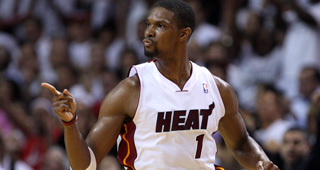With the Miami Heat down 3-2 to the suddenly revitalized Boston Celtics in the Eastern Conference Finals, the season of a team bigger than the sport they play in will come down to an injured forward who wasn’t even the best player on his high school team. From the very beginning of his basketball career, Chris Bosh has been misunderstood and underappreciated; Game 6 is his chance to change that.
At Dallas Lincoln, he played in the shadow of his high school classmate Bryan Hopkins, an electrifying athlete who was recruited by nearly every school in the country. At 5’11, 195, Hopkins was rumored to have a 40’ vertical, and he would put on a dunking exhibition during pregame warmups to the delight of the crowds.
Bosh, a skinny late bloomer, was first noticed by college scouts when they came to recruit Hopkins. In their senior season, the two became a devastating one-two punch for a Lincoln team that went 40-0 and won the mythical high school national championship.
Hopkins wound up at SMU, the only school who would offer his twin brother Ryan a scholarship, while Bosh signed with Georgia Tech, in part because of the school’s academic profile. He averaged 16 points, 9 rebounds and 2 blocks on 57% shooting for the Yellow Jackets, but he remained well under the national radar as a team comprised almost exclusively of freshman and sophomores went 16-15 and missed the NCAA Tournament.
Most NBA stars make their reputation in the Rookie of the Year race, and in a normal season, a 19-year old putting up 12 points, 8 rebounds and 1.5 blocks on 46% shooting would get some notice. Of course, 2003 was hardly a normal season, as Bosh faded into the background on a 33-49 Toronto Raptors team while LeBron James, Dwyane Wade and Carmelo Anthony got all the headlines.
In 2004, the Raptors took Rafael Araujo with No. 8 selection; the oafish center lasted only three seasons in the NBA while posting a career average of 2.8 points on 41% shooting. Despite having an excellent jump-shooting big man, they began drafting players who (poorly) replicated Bosh’s game, taking Charlie Villanueva No. 7 in 2005 and Andrea Bargnani No. 1 overall in 2006.
Bosh, meanwhile, became one of the NBA’s most dangerous scorers. A skilled and athletic 6’11, 225 forward with a 7’3 wingspan, he could get an extremely accurate shot off against almost any defender in the league. By his third season, at the age of 21, he averaged 22.5 points, 9.2 rebounds and 2.6 assists on 50.5% shooting.
For the next four seasons, Bosh was stunningly consistent, scoring at least 22 points and averaging less than 10 rebounds a game only once. But because his game revolved around skill and finesse rather than power, he was written off as soft, maligned for what he could not do rather than appreciated for what he could.
In his final season with Toronto, he averaged 24 points, 11 rebounds, 2.5 assists and 1 block on 52% shooting. However, that didn’t move the needle all that much on a 40-42 team that missed the playoffs for the second consecutive season.
Of course, Bosh was hardly the reason for Toronto’s lack of success, and the team sunk to the depths of the NBA after he departed in free agency in the summer of 2010. I’d like to see Kevin Love win a playoff series with Minnesota before we act like what Bosh accomplished without another All-Star in Toronto with him after his rookie season wasn’t impressive.
But while Bosh found the first sustained success of his career with Miami, his reputation from his Toronto days still lingered. The Heat were often referred to as “2.5 Men”, and Bosh’s penchant for honesty and introspection became a easy punchline for the team’s many critics.
Yet there’s a reason LeBron and Wade thought so highly of Bosh that they brought him along in their audacious plan to take over the NBA, and there’s a reason why he’s made the All-Star team seven times in his nine-year career. There aren’t many 6’11 players who can create their own shot, and there are even fewer who can also stretch the defense like Bosh can to create driving lanes for the Heat’s two superstars.
Ever since his injury, floor spacing has been a huge problem for Miami. It culminated in Game 5, with Kevin Garnett completely abandoning Udonis Haslem for large stretches of the fourth quarter to contest LeBron and Wade at the rim. While Bosh is clearly not at 100%, his ability to score from the perimeter puts Boston’s defense in a bind by keeping Garnett outside of the paint, since none of their other big men can match up with him.
Game 6 will be the biggest game of Bosh’s career since the Texas Class 4A high school championship game in 2002, when Lincoln faced off against a Beaumont Ozen team headlined by Kendrick Perkins. The two future NBA players, men amongst boys at the high school level, fought to a draw in the first half, before Bosh realized Perkins had no answer for him on the perimeter. Lincoln pulled away in the second, as Bosh began raining down jumpers against a Beaumont team with no match-up for his combination of height and shooting ability.
Those are the two thing which correlate the most with career longevity, which is why Bosh, still only 27-years-old, will likely make over a dozen All-Star teams before his career is over. He’s on pace to become a Hall of Famer, and Miami will need him to play like one on Thursday to stay alive.

Jonathan Tjarks wrote on the NBA for RealGM from 2011-2016 before joining The Ringer.
Follow @JonathanTjarks on Twitter.


